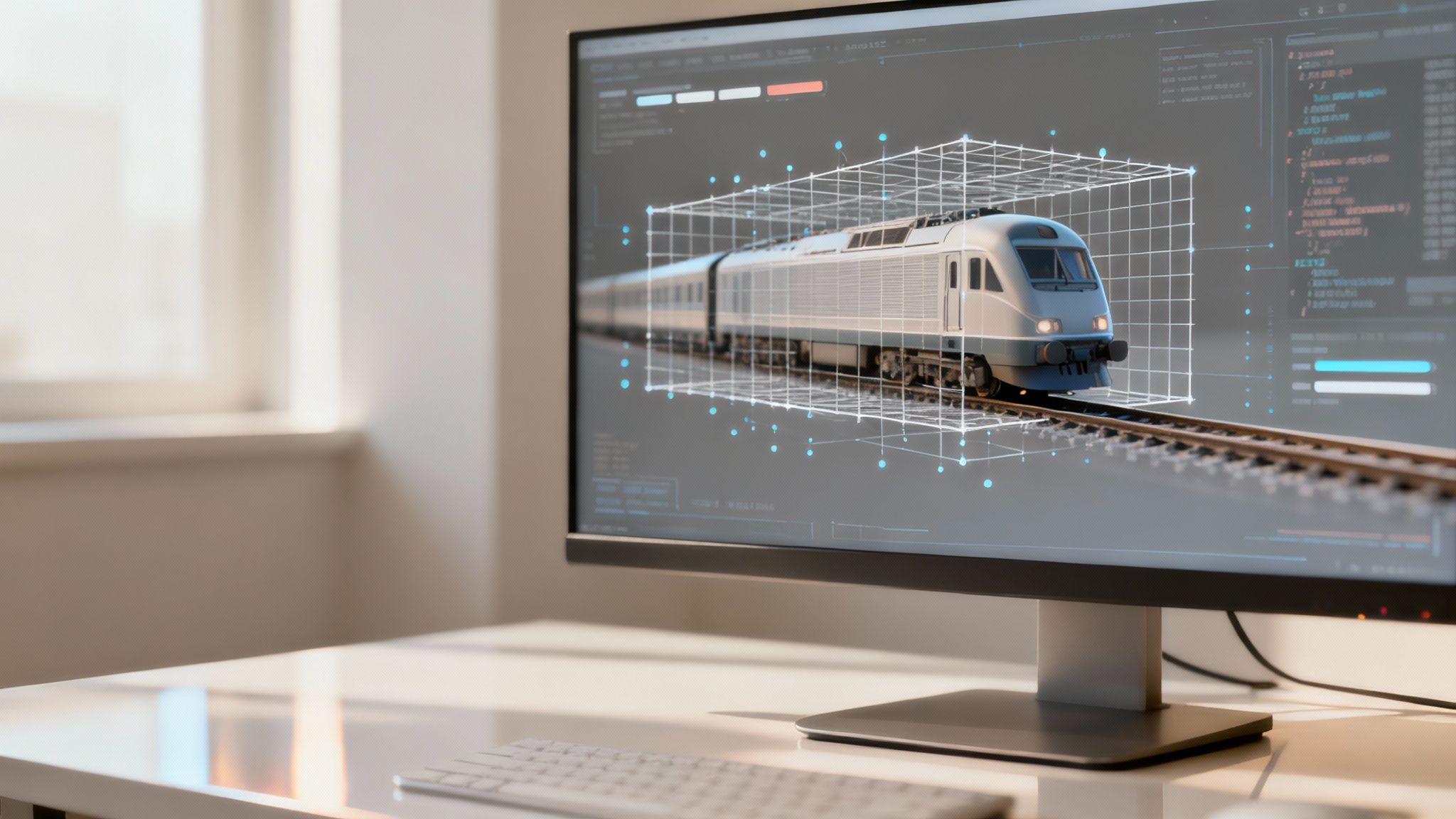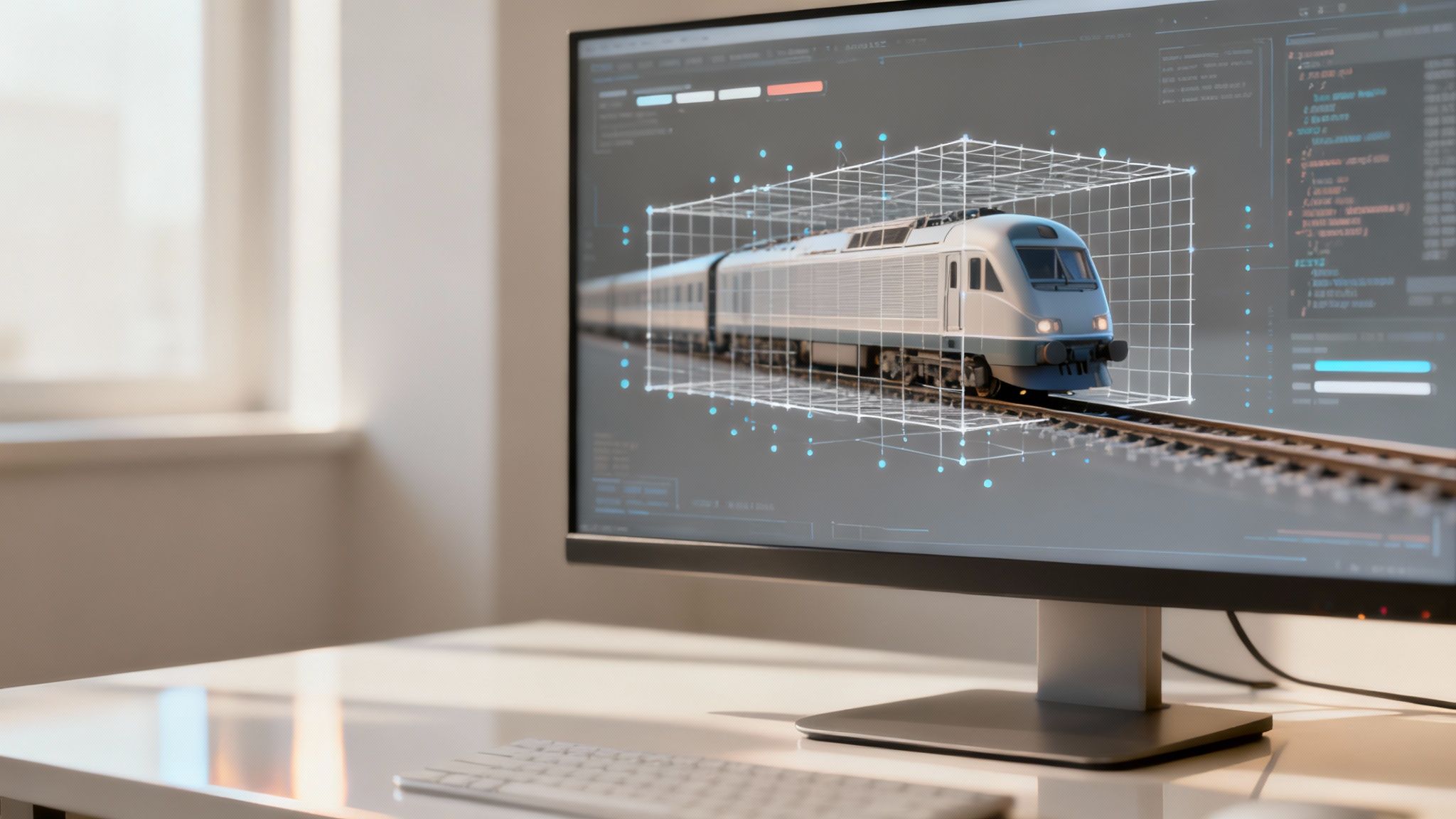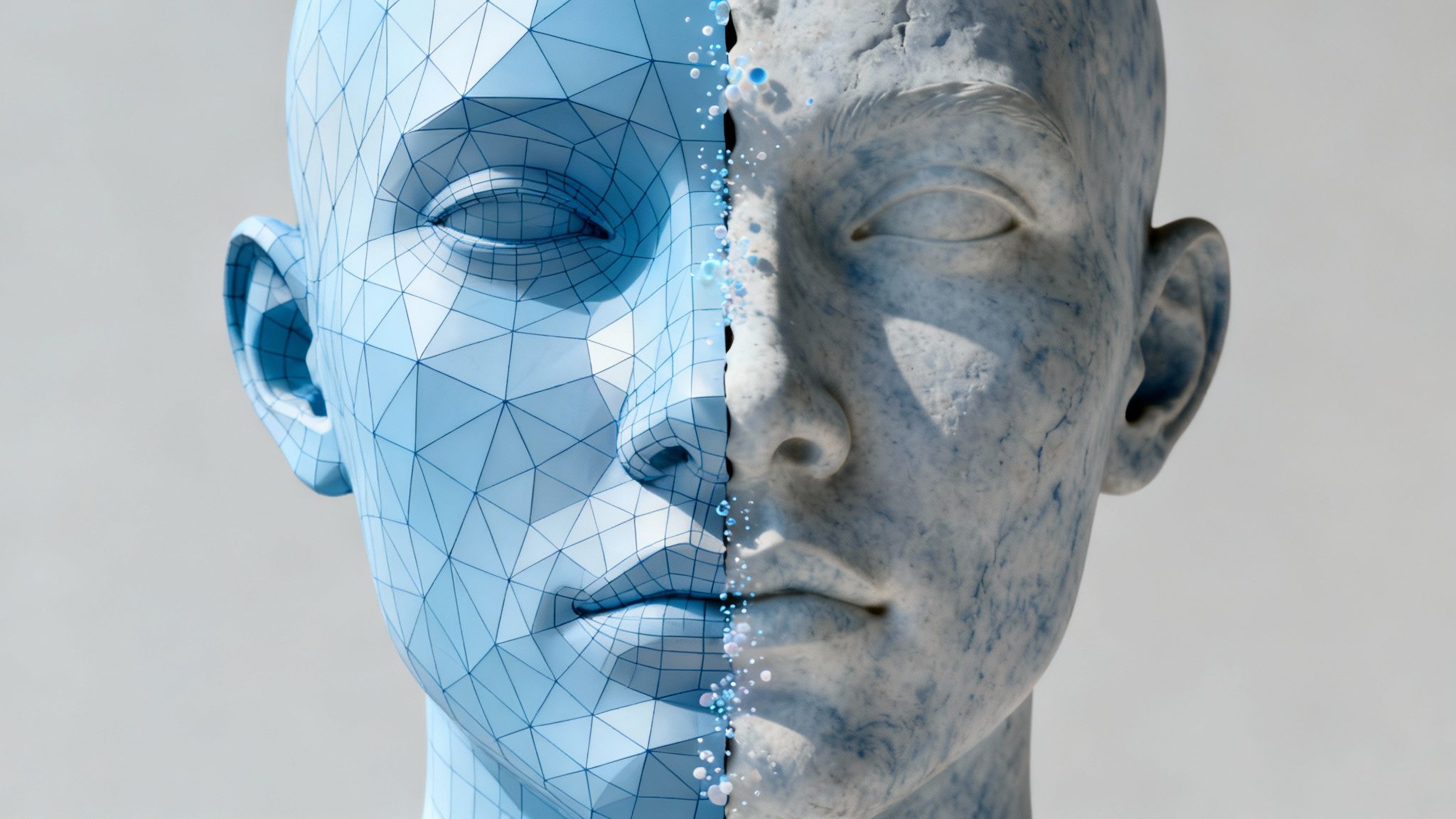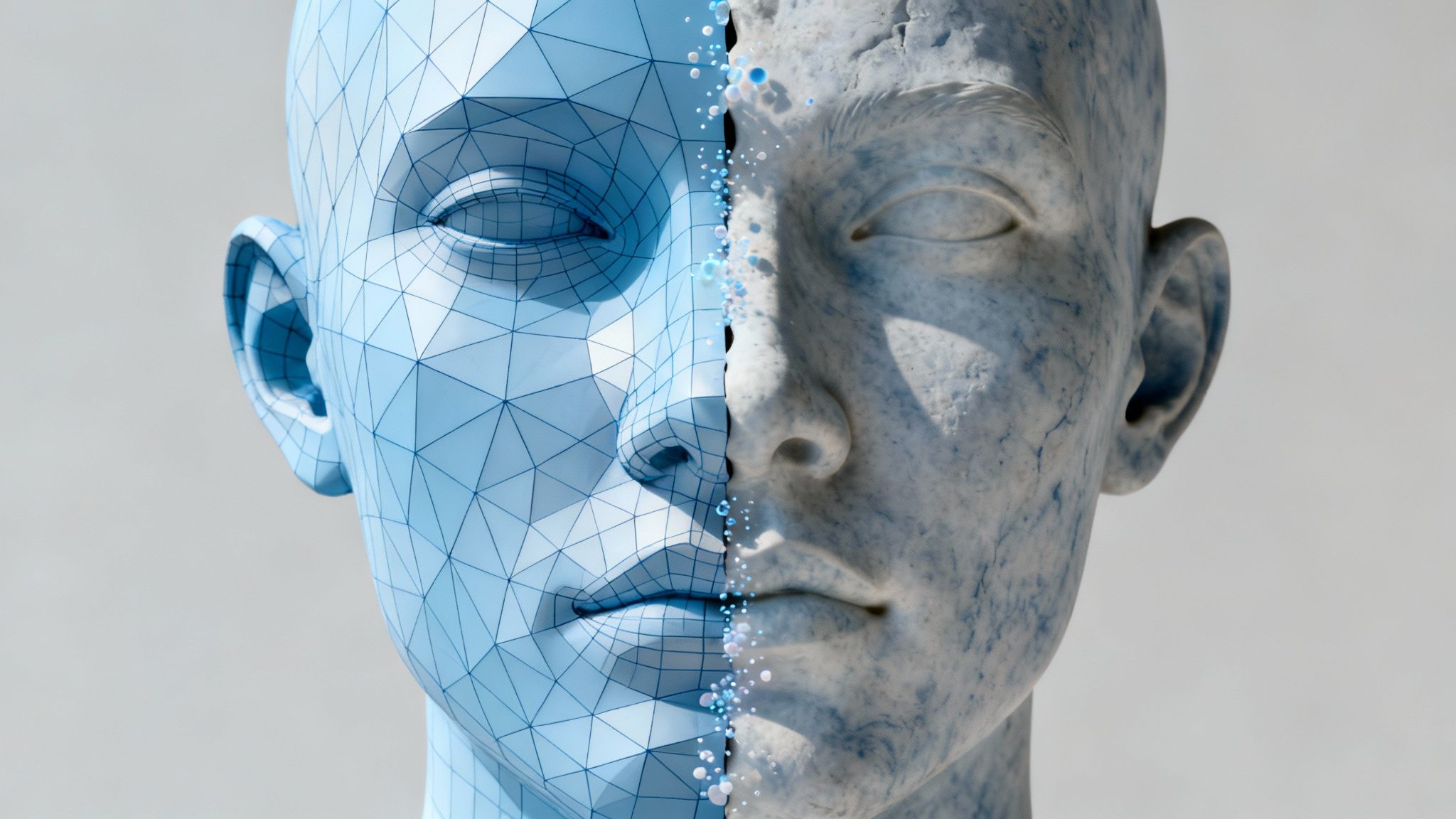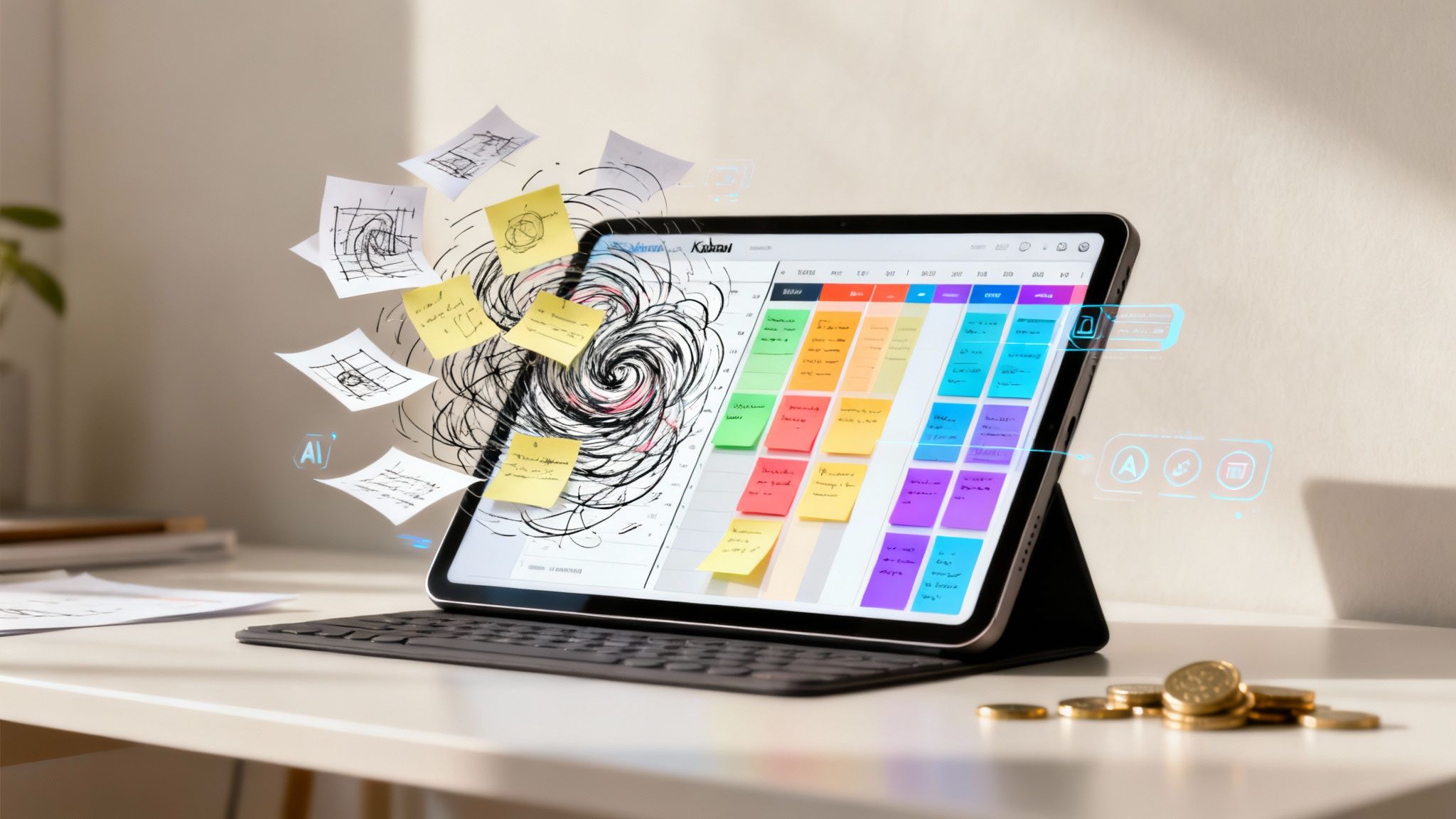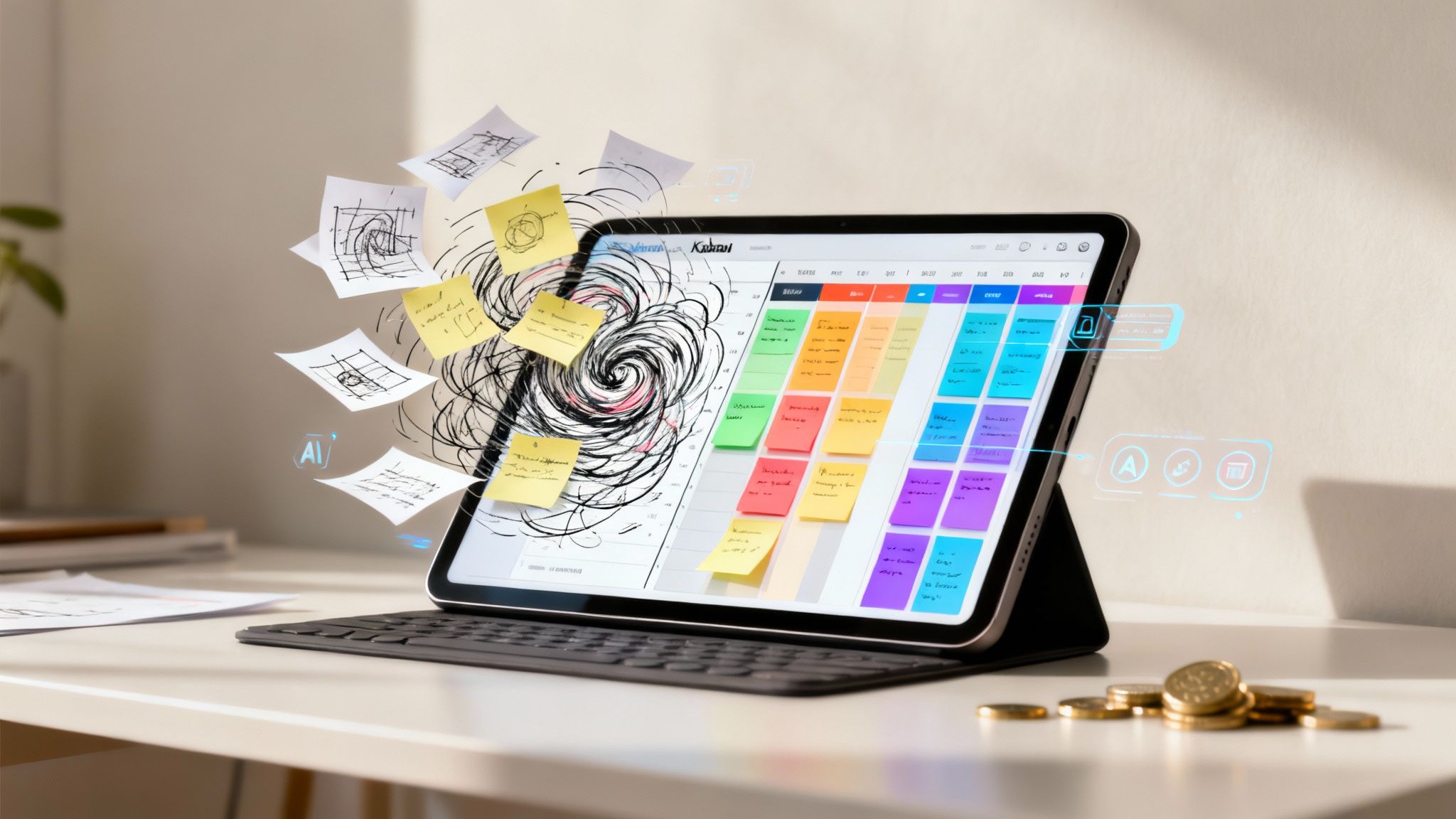Achieving professional results when you train 3D models requires a solid foundation. This starts with clear project objectives and high-quality, organised data. This initial preparation phase is the most critical step for ensuring the AI can learn effectively and deliver enterprise-grade results that align with your creative vision and compliance requirements.
Setting the Stage for Successful 3D Model Training
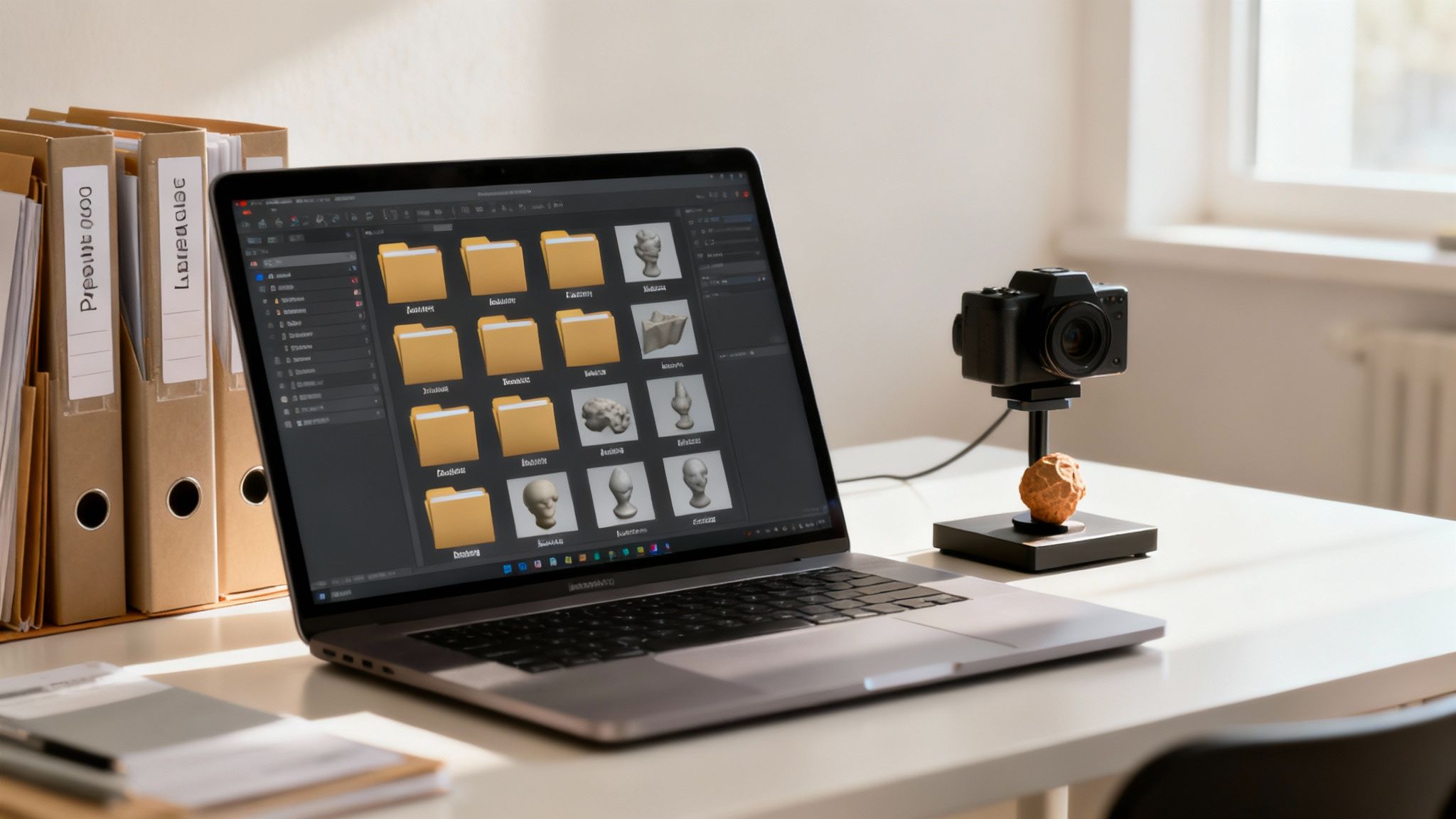
Before initiating a training session, establishing the proper groundwork is essential. This process involves more than simply uploading a folder of assets into an algorithm. It is about translating a creative intent into a structured, compliant plan that an AI can understand and execute reliably.
Most unsuccessful training experiments stem from a rushed or poorly organised setup. This approach often leads to unpredictable outcomes, wasting valuable time and resources.
A successful project begins with well-defined goals. Instead of a vague objective like "create a realistic car model," be specific: "train an AI to generate late-model European sports cars with PBR textures and consistent topology for real-time rendering." This level of detail guides every subsequent decision, from data collection to parameter tuning, ensuring a focused and professional workflow.
Defining Your Training Objectives
First, crystallise your vision into actionable training objectives. This clarity is essential for defining success and ensuring final models meet your quality and compliance standards. Take a moment to articulate what a "good" result means for your project.
Consider the following key questions:
- What is the final application? A model intended for a mobile game requires different optimisations than one for a cinematic render or a product visualiser.
- What level of detail is required? Be specific about the target polygon count, texture resolution, and geometric accuracy.
- What is the target style? Define whether you are aiming for photorealism, a stylised aesthetic, or a more abstract form.
Establishing these details from the outset ensures alignment across the project team, from artists to project managers.
Curating High-Quality Source Data
The quality of your training data directly determines the quality of your AI-generated models. The task is to assemble a dataset that is clean, consistent, and relevant to your objectives. This data can originate from various sources, including photogrammetry scans, manually created models, or licensed asset libraries.
A well-organised dataset is the bedrock of any successful AI training initiative. Poor data quality is the single most common point of failure, leading to models that are inaccurate, flawed, or unusable for professional creative work.
The potential applications are extensive, from creating detailed simulations for technical industries to developing assets for creative projects. For example, teams can leverage AI-powered tools for generating 3D characters, such as Pixar-style models, which demonstrates the creative power a well-trained system can provide.
To ensure the AI can process assets correctly, implement a logical folder structure and strict naming conventions from the start. A simple methodology like /dataset/category/model_name_v01.fbx can prevent common file path errors and make the process more manageable and secure.
Prepping Your Dataset for Peak AI Performance
The potential of any AI model is directly tied to the quality of the data it learns from. It is not enough to simply collect files; for enterprise-level 3D work, it is necessary to apply essential optimisation techniques to ensure the AI learns the intended characteristics.
This hands-on preparation primes your dataset for the Virtuall platform. Executing this step correctly will reduce training errors and significantly elevate the quality of your final output.
Feeding an AI inconsistent, messy data is analogous to teaching a language with a disorganised dictionary containing incorrect definitions. The system will struggle, and the results will be flawed. A clean, standardised dataset provides the clarity needed for effective, compliant learning.
Normalising Models for Consistency
The first critical task is normalisation. This involves standardising the scale, orientation, and origin point for every model in your dataset. The AI requires a consistent frame of reference to understand an object's properties, regardless of its original creation or export settings.
If this step is skipped, the AI might incorrectly interpret a small chair and a large one as entirely different objects rather than variations of the same class.
- Consistent Scale: Ensure all models are scaled uniformly. For example, all vehicles could be set to their real-world dimensions in metres.
- Uniform Orientation: Align every model to a standard axis. A common practice is to have the "front" of an object face the positive Y-axis.
- Centred Origin: Place the pivot or origin point of each model at a consistent location, such as the centre of its geometry or its base.
This foundational step is vital for any professional 3D training application.
Cleaning and Simplifying Meshes
Next, address the geometry itself. Raw 3D models, especially those from 3D scans or created by different artists, often contain hidden errors that can disrupt the training process. The goal is a clean, efficient, and "watertight" mesh for every asset.
This involves identifying and fixing issues such as:
- Non-manifold geometry: Edges shared by more than two faces.
- Flipped normals: Faces pointing in the wrong direction, which affects lighting and rendering.
- Overlapping vertices: Multiple points occupying the same space.
A clean mesh is non-negotiable for enterprise-grade AI training. Geometric errors introduce noise and ambiguity, forcing the AI to waste computational resources trying to interpret flawed data, which almost always results in poor-quality outputs.
Simplifying complex models, often called polygon reduction, is equally important. High-poly assets can slow training without adding useful information for the AI. Use retopology tools to create a simpler version of the model that retains its core shape but has a much lower polygon count.
Remember to select an appropriate file type for your optimised assets. If you are unsure, our guide on 3D model file formats is an excellent resource.
Using Data Augmentation for 3D Assets
Finally, to build a truly robust and versatile AI, you can use data augmentation. This means creating strategic variations of your existing assets to expand the dataset without requiring additional unique models. For 3D, this often involves programmatically altering attributes like lighting, materials, and textures.
For instance, by applying hundreds of different realistic material presets to a single car model, you teach the AI to understand the object's form independently of its surface. This helps the model generalise better, making it more adaptable and reliable for creative applications.
The use of 3D models is expanding across industries, from creative studios to infrastructure. In Denmark, the focus on digital innovation in sectors like transportation highlights this trend, which is part of a global 3D modelling market projected to hit USD 11.8 billion by 2028.
Tuning the AI: How to Configure Your Training Parameters in Virtuall
With your dataset prepared, the next step is configuring the AI. This is where you configure the training parameters in Virtuall, translating your creative vision into clear, technical instructions for the platform.
Consider this process less like complex data science and more like adjusting the settings on a professional camera. The right combination of adjustments is what separates an amateur result from a crisp, professional one. Similarly, your parameters guide the AI toward the bespoke, predictable results your project requires.
The Trade-Off: Speed vs. Precision
At the heart of AI configuration is a constant balance between training speed and output detail. The primary parameters you will adjust are learning rate, batch size, and the number of epochs. Understanding the function of each is key to achieving desired results without inefficiently using time and computing resources.
For instance, a high learning rate prompts the AI to make large, rapid adjustments. This can produce a rough result faster but may overshoot the optimal outcome. Conversely, a lower learning rate is more methodical, making it ideal for fine-tuning but slower to converge.
The objective is not to find a single "perfect" setting immediately. Instead, it is about establishing a solid starting point based on your model type, then monitoring and adjusting as needed. This iterative, responsible process is a hallmark of professional AI training.
Your Key Dials and Where to Start
Let’s break down the most important settings and provide practical starting points for different kinds of 3D models. Consider these as a baseline for experimentation within the Virtuall platform.
- Learning Rate: This controls the magnitude of the AI's adjustments with each step. For a highly detailed character model requiring nuance, a low learning rate like 0.0001 is a good starting point. For simpler, hard-surface architectural assets, a higher rate around 0.001 can be more efficient.
- Batch Size: This is the number of data samples the AI processes at once. For architectural models, a larger batch size (e.g., 64 or 128) can accelerate training by providing a broader overview of general shapes. For organic models with many variations, a smaller batch size like 16 or 32 often yields more detailed results.
- Epochs: An epoch is one complete training cycle through your entire dataset. Too few epochs will result in an under-trained, generic model. Too many can lead to "overfitting," where the AI memorises the data instead of learning from it. A good starting range is between 500 to 1,500 epochs, depending on the size and complexity of your dataset.
Here’s a quick-reference table to help you get started.
Key AI Training Parameter Settings
This table summarises the essential parameters and provides recommended starting points. Remember, these are guidelines—your specific dataset may require fine-tuning.
Once you are comfortable with these settings, you can move from speculative adjustments to strategic decisions. This level of technical control is becoming a core skill for modern creative teams. Many studios now integrate various AI tools for 3D modelling to elevate their work. Virtuall consolidates this control, making the entire process faster and more collaborative for your studio.
Launching and Monitoring Your Training Session
After preparing your dataset and configuring the parameters, you can initiate the training session on the Virtuall platform. This is where your foundational work begins to yield results.
While starting the training is straightforward, the key to success lies in effective monitoring. This is not a "set it and forget it" process. It requires active oversight to ensure the model learns correctly and to intervene if it deviates from the intended path. Proactive monitoring can save a significant amount of time and compute resources.
Interpreting Real-Time Feedback
The Virtuall dashboard provides a window into the AI's learning process, offering crucial feedback through metrics like loss curves and validation scores. Understanding these is essential.
The loss curve is your primary progress indicator. Ideally, this curve will decrease steadily before plateauing. This indicates that the model is learning the underlying patterns in your data rather than simply memorising the examples provided.
If the curve is erratic, your learning rate may be too high, causing the AI to overcorrect. Conversely, if the curve flattens almost immediately, the learning rate might be too low, indicating the model has stopped improving.
The goal is not merely to achieve the lowest possible loss value, but to ensure stability. A model that achieves a low loss by memorising the dataset is not useful for generating new assets. True success is a model that can generalise its learning to generate novel, high-quality content.
This decision tree illustrates how different model types can shape your initial approach.
As the infographic shows, your initial decisions are critical. Whether you are aiming for the precise lines of architectural models or the fluid shapes of organic forms will determine the direction of your AI's configuration.
Spotting Common Training Issues
Beyond monitoring graphs, it is important to visually identify signs of common issues. Two problems that frequently arise are overfitting and underfitting.
- Overfitting: This occurs when a model becomes too focused on the training data. The primary symptom is the generation of assets that are nearly identical copies of your source files instead of new variations. The model has memorised, not learned.
- Underfitting: This is the opposite problem, where the model fails to grasp the important patterns in your data. This results in outputs that are generic, undefined, or incorrect, indicating that the learning process was ineffective.
This type of hands-on monitoring is increasingly vital, especially as 3D modelling plays a larger role in complex European projects like infrastructure planning. The European 3D modelling market grew from $389.091 million in 2021 to an expected $669.436 million in 2025—a growth of over 58%. This expansion is driven by the need for detailed digital models for everything from new buildings to entire rail networks.
You can read more about the 3D modelling market growth and its drivers. By identifying issues like overfitting early, you can ensure your project remains on track for a high-quality, successful outcome.
Validating and Refining Your Trained 3D Model
Once the training session concludes, the validation process begins. This is where you test your new 3D model to confirm it meets your quality and safety standards. This step combines technical analysis with creative evaluation to ensure the final output is both technically sound and visually appealing.
The process consists of two key phases. First, an analysis of the quantitative metrics provided by Virtuall. Second, a hands-on visual inspection to determine if the generated assets meet creative and professional standards.
Analysing Quantitative Metrics
The data from your training session provides valuable insights. You should immediately review the final validation loss and accuracy scores. A low, stable loss score is a positive indicator that the model has effectively learned the patterns in your data without memorising them.
However, do not rely solely on these metrics. High accuracy scores are beneficial, but they do not guarantee the model has aesthetic quality. Think of these numbers as a preliminary technical health check before proceeding to the more subjective visual review.
Conducting Qualitative Visual Inspections
For any creative project, the visual result is paramount. The metrics can be perfect, but if the generated assets are not visually correct, the model is not successful. A structured checklist is essential for evaluating the outputs against your original objectives.
Key areas to inspect include:
- Geometric Integrity: Are the shapes clean? Look for common AI-generated flaws like warped surfaces, non-manifold geometry, or unintended holes in the mesh.
- Texture and Material Accuracy: Do the surfaces appear correct? Check for blurry, smeared, or illogical textures. For detailed work, inspect normal maps for correctness. Our guide on how to make a normal map provides a solid baseline for what to look for.
- Stylistic Cohesion: Does the output consistently match the art style defined at the project's outset? Consistency is a key measure of success.
This detailed visual review prepares your assets for a real-world production pipeline.
A model can be technically perfect but creatively unsuitable. Rigorous visual validation is the final quality gate that confirms your AI-generated assets meet the artistic and compliance standards required for enterprise use.
Gathering Feedback for Iterative Refinement
Validation is a collaborative process. Involve key stakeholders by presenting a curated selection of the best-generated models to art directors, project managers, and clients for structured feedback. This collaborative review can identify subtle issues or creative misalignments that might be missed by a single individual.
This feedback loop drives meaningful improvement. Use these insights to determine the next steps—whether that involves adjusting the training dataset, tweaking parameters for another run, or approving the model for deployment.
This iterative approach to development is prevalent across the 3D industry. In Denmark, for example, the construction and design software market is projected to reach approximately 63.09 million Danish Kroner by 2025, largely driven by these technologies. You can discover more insights about Denmark's design software market on Statista.com. A structured process like this ensures that your effort to train 3D models produces assets that are not just technically sound, but truly ready for professional application.
Common Questions About Training 3D Models
Even with a clear process, venturing into AI-powered 3D asset generation can bring up common questions. Addressing these early helps maintain best practices and keeps projects on track, both creatively and from a compliance standpoint.
We frequently encounter the same queries on the Virtuall platform. Let's address them to prevent potential roadblocks and allow your team to focus on creative work.
How Much Data Do I Really Need to Train a 3D Model?
This is the most common question we receive. The answer depends entirely on your objective; there is no single magic number.
If you are training a model on a very specific object style—for example, a particular brand of Scandinavian chair—you can often achieve excellent results with a tightly curated dataset of just 50 to 100 high-quality examples.
However, if the goal is for the AI to generate a wide variety of assets within a broader category, such as "sci-fi vehicles," a much larger dataset is required. In this case, a range of 1,000 to 5,000 examples is more appropriate to provide the model with sufficient diversity. The key principle is always to prioritise quality and consistency over sheer quantity.
What’s a Realistic Training Time?
This is another question where the answer depends on several factors, including the complexity of your 3D models, the size of your dataset, and your chosen training parameters. A simple session with a small, clean dataset might complete in just a few hours.
For more ambitious, enterprise-scale projects involving thousands of high-polygon models, you should anticipate training times ranging from 24 to 72 hours. While Virtuall is optimised for speed, it is prudent to incorporate these timelines into your project schedule, particularly during the initial experimentation phase.
Remember, the first training session is rarely the last. The most successful projects involve several rounds of training. Insights from one run are used to refine the dataset and parameters for the next, leading to progressively better results. This iterative loop is fundamental to mastering AI for creative production.
Troubleshooting and Staying Compliant
When an error occurs, it can almost always be traced back to dataset preparation. Common issues include inconsistent scaling, non-manifold geometry, or simple file naming errors. Before taking other troubleshooting steps, thoroughly review your preparation workflow.
For enterprise teams, compliance is non-negotiable. This means you must use only fully licensed or original source data for training models. Virtuall's organised workspace is designed to help you track asset provenance, ensuring your AI-generated models are built on a compliant foundation and are safe for commercial use. This responsible approach protects your intellectual property and that of your clients.
Ready to unify your creative workflow? With Virtuall, your team can generate, manage, and collaborate on 3D models, images, and video—all in one secure, browser-based workspace. Move from concept to final asset faster than ever before.

